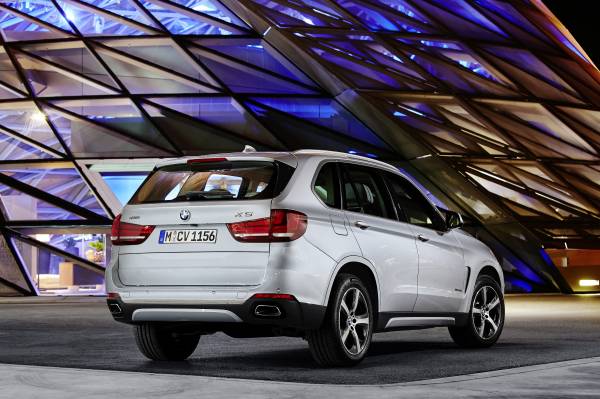BMW Brings I Series PHEV Tech To X5 XDrive40e
Having experimented with its i Series, BMW is bringing over its PHEV technology to its core collection, beginning with the X5 xDrive40e.
Power for the PHEV crossover comes from a 2-liter four-cylinder using BMW’s TwinPower Turbo system paired with a synchronous electric motor integrated into the crossover’s eight-speed automatic. A combined 313 horses and 332 lb-ft of torque are sent to all corners, helping to push the X5 from nil to 62 in 6.8 seconds. Top speed is limited to 130 mph, 75 mph in electric-only mode. Range is 19 miles on its 9-kWh lithium-ion pack.
Said pack reduces cargo space to 17.65 cubic feet with the rear seats up, 60.7 cubic feet with the seats down. The pack can be charged at home with the same charging units used by i3 and i8 owners, as well as through brake regeneration and at public charging stations.
Other features include an M Sport package, adaptive suspension, and bespoke offerings from BMW Individual.
No word on pricing or availability thus far, but European customers will be able to get theirs in the fall.
Seattle-based writer, blogger, and photographer for many a publication. Born in Louisville. Raised in Kansas. Where I lay my head is home.
More by Cameron Aubernon
Latest Car Reviews
Read moreLatest Product Reviews
Read moreRecent Comments
- AZFelix The younger demographic is also more likely to have a septum piercing. So there's that to consider when evaluating the profundity of their decision making.
- Haze3 The main advantages of this scheme would seem to be low/isolated pollution (single source NG) and high uptime. Electric is definitely better for net particulate at worker level and may also be preferred for long term maintenance.This said, the CA grid runs a little under 40% fossil fuel (pretty much all NG), so charging these trucks directly from the grid would have lower emissions than generating directly from 100% NG. It would also be more power efficient. However, it's likely that supply reliability and cost would be worse (this cuts out the power co). This is a LOT of charging.Overall efficiency should be equal to or a little worse than direct NG fueling, depending on NG generation process type. Should run 30-40% vs. 40% for direct NG fueling.
- Canam23 When I moved to France a little over two years ago, one of the first things I noticed is the French buy French... everything. Seven out of ten cars you see on the road are French. When you go to the Home Depot equivalent, almost all the products are French or European Union, even the food in the grocery stores is labeled as being produced in France. This probably isn't surprising from a country that makes its own airliners, fighter jets and submarines but coming from the US where so much is imported from outside and especially from China, this was a revelation. Does France have protective tariffs? Yes, but nothing over the top. The French are proud of their products and they enjoy their employment and the benefits they receive. They do sell a Chinese brand here, MG, and you get a bit more for your money, but not much.If Americans had the same attitudes as the French, there might be a lot more manufacturing jobs in the US.
- Fred Remember when "made in Japan" was cut? Face it people bought 10 year old Fiats made behind the iron curtain. People will always shop price, the rest be damned.
- FreedMike Wow, and here I was thinking the EV haters were raring to go out and buy one, and then this. Tragic.

















































Comments
Join the conversation
X5xDrive40e. No, really: X5xDrive40e.
Is it just me or is the X5 getting really old looking these days? I feel like it needs a complete re-do, as it's got to still be on that late 90s platform.